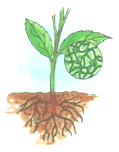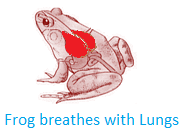Living Things Breathe
Living things breathe air to live. Practice the activity to check this on your own.
(i) We can press our nostrils between our thumb and finger now we are unable to breathe and we feel uncomfortable. When we release our thumb and finger now we can breathe easily and feel comfortable. So, we need air to breathe.
(ii) We can keep our hands in front of our nose and we can feel that air coming out of our nose at a regular interval and it shows that we breathe out. Now we can hold our breath for a few seconds with our fingers, we feel uncomfortable. As soon as we release our nose we at once start to take in deep breaths. So, it shows that we cannot live if we do not breathe in.
Similarly, like us animals and plants also breathe to live.
|
(iii) If we keep a plant in a closed box the plant will not be able to breathe and it will soon dry up and die. We might think that plants do not breathe because they do not have a nose. It is true that plants do not have noses, but they breathe through very small openings in their leaves called stomata. So, it shows that a plant also needs air to breathe. |
(iv) Like us, most of the animals breathe through their nose.
Ants, grasshoppers, cockroaches, etc. breathe through air holes in their bodies.
Thus, from the above discussion we come to know that all living things can breathe to live. Human beings, animals and plants need air to breathe.
Non-living things do not breathe. We haven’t seen a table or a chair breathing air. A table or a chair does not breathe since, they are non-living things.
Living Things Need Food and Water
Animals and PlantsFrom Living things Breathe to HOME PAGE
Recent Articles
-
What Is Plasma? | Blood Plasma | Proteins | Nutrients | Cholesterol
Nov 07, 25 10:29 AM
Blood is a mobile fluid which is a connective tissue and is derived from the mesoderm like cell any other connective tissue. Colour of blood is reddish and that flows inside the blood vessels by means… -
Disorders of Respiratory System | Tuberculosis | Pleurisy | Emphysema
Oct 28, 25 11:39 PM
Tuberculosis is very common disease and is caused by a type of bacteria called Mycobacterium tuberculosis. This disease causes different trouble in the respiration and infection of several parts of th… -
Regulation of Respiration | Respiratory Centres | Inspiratory Area |
Oct 14, 25 12:13 AM
Respiratory Centre is the area that controls the rate of respiration and it is observed to be located in medulla oblongata and pons. Respiratory Centre has the following will dispersed components like… -
Explain Transport of Gases | External Respiration | Tissue Respiration
Oct 09, 25 11:35 PM
In humans gaseous exchange is completed in the following ways the steps are - External Respiration or Breathing - Breathing in false taking in of Oxygen and giving out of carbon dioxide in the body. M… -
Kind and Number of Teeth | Location of Teeth in Mouth | Care of Teeth
Sep 11, 25 12:52 AM
Kind and Number of Teeth








New! Comments
Have your say about what you just read! Leave me a comment in the box below.